Buffalo Says Farewell to President William McKinley
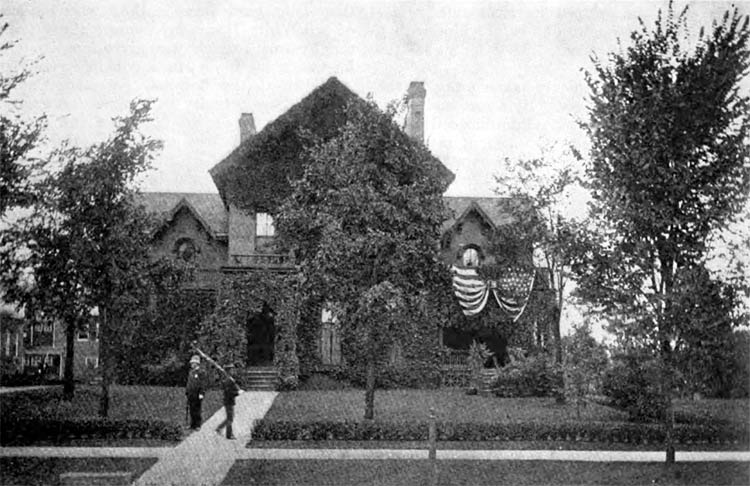
Milburn residence, 1169 Delaware Avenue. Image source: Monthly Review of Reviews, 1901
President William McKinley arrirved in Buffalo on September 4, 1901. His purpose was an official visit to the Pan-American Exposition, a visit that was hoped for in May but was postponed on account of his wife's poor health. He entered the Exposition grounds late in the afternoon of September 4 at the Exposition train station north of the Electric Tower. He and his wife crossed the grounds in a carriage, exiting at the Lincoln Road gate on their way to 1168 Delaware Avenue, home of John G. Milburn, president of the Pan-American Exposition Company. They were guests of the Milburns during their planned two-day stay in Buffalo.
The next day, September 5, was President's Day on the Exposition grounds. A large covered rostrum had been constructed on the Esplanade, the largest open space on the grounds. There, at 10 a.m., President McKinley gave a speech to a crowd that filled the Esplanade. Later, after touring selected builidings, he attended a reception in the U.S. Government Building. During these events, he was only briefly in the public eye; buildings on his tour had been closed and emptied of visitors. He was guest of honor at a lunch for 200+ at the New York State Building.
After a long day, he and Mrs. McKinley returned to the grounds following dinner at the Milburns, this time to watch the Exposition illumination and fireworks from the Triumphal Bridge. Their official agenda for President's Day was ended.
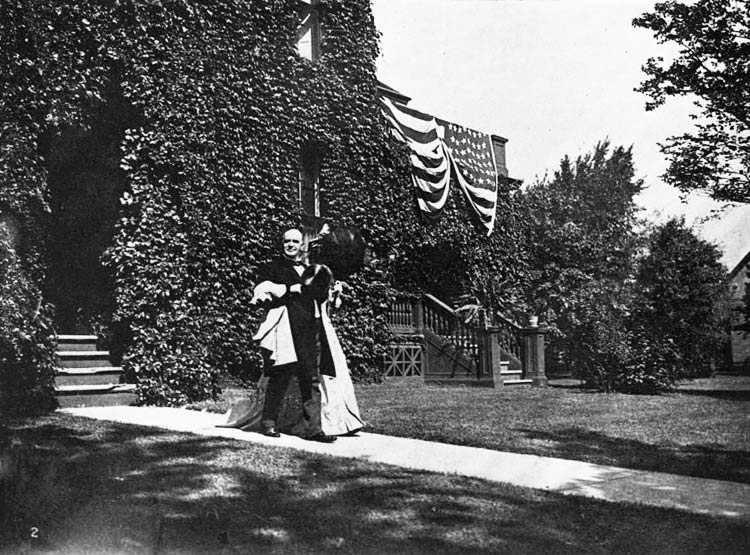
President and Mrs. McKinley leaving the Milburn house on his last day of life. Image source: Authentic Life of William McKinley
The next day, the McKinleys emerged from the Milburn house and followed a separate agenda for the day. While Mrs. McKinley remained in Buffalo, the President traveled to Niagara Falls via the Great Gorge railroad and enjoyed the day as a tourist. Returning to Buffalo, he had one more task before a final dinner at the mansion of George Williams: a handshaking reception for the public in the Temple of Music. Less than ten minutes later, at 4:07 p.m., McKinley was wounded by two shots from a concealed handgun by anarchist Leon Czolgosz. After treatment at the Emergency Hospital on the Exposition grounds, he was transported by ambulance to the Milburn house.

Press
and police tents, across the street from the Milburn house. Image source: private collection
Members of the press had already been installed on a vacant lot at the corner of Delaware and West Ferry near the Milburn house. It was expanded to include members of the military on September 7 because the Milburn home became federal property beginning that morning. Police installed ropes along the street and at nearby intersections to prevent the curious or concerned from encroaching on the Milburn house and to ensure silence for the President and his wife. Telegraph operations, which had been set up in the Milburn carriage barn, were moved across to the press area to eliminate the noise from the incessant clacking of the key.
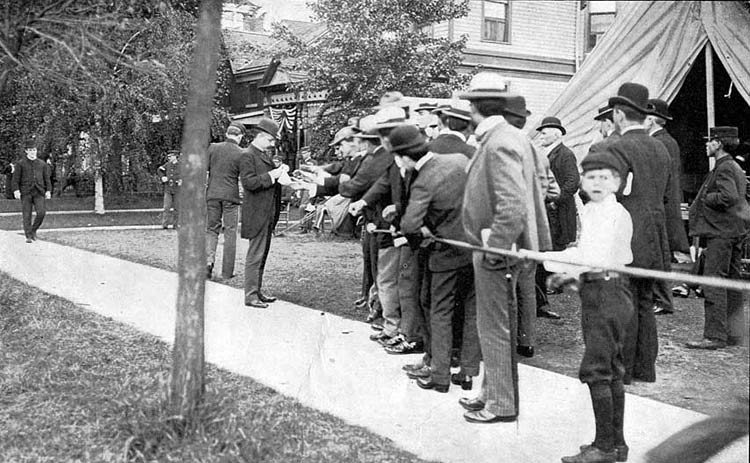
President McKinley's secretary, George Cortelyou updating the press on the President's condition. Image source: The True Story of the Assassination...
Buffalo and the rest of the country awaited daily bulletins from the Milburn house detailing the President's condition, and newpapers across the country detailed what and how much the President ate, how well and how long he slept, and his state of mind. McKinley died in the middle of the night on September 14th. Vice-President Theodore Roosevelt arrived in Buffalo and was driven to the home of Ansley Wilcox at 646 Delaware Avenue. At 3:30 p.m. on the 14th, he was sworn in as President.
The directors of the Exposition closed the gates to visitors Saturday the 14th and Sunday the 15th. But the Exposition Board was not idle; the members of the committee on ceremonies handled arrangements for the President's services at the Milburn home, the body lying in state at City Hall on the 15th and exit from the city on the 16th.
Services at the Milburn home were held on Sunday morning, September 15, at 10 a.m. Furniture was removed from the big parlor on the north side of the home where the casket would be placed. "The room was crowded with flowers...They cast a heavy fragrance throughout the entire house." Two other rooms were also cleared of furniture and folding chairs arranged in each to accomodate the cabinet and as many dignitaries and influential residents as possible. Those not invited to crowd into the home stood on the lawn outside. Everyone in the vicinity of the home had an invitation; the general public was kept a block away. Much praise was given to the Buffalo police who were prompt in attending to those who fainted or jostled in the crowds.
The service was led by Rev. Dr. Charles Edward Locke of the Delaware Avenue Methodist Episcopal Church. He was described as "pale, smooth shaven, black curly hair, his dark eyes shining with tenderness." Hymns were sung by the 4-person choir of the First Presbyterian church: "Lead, Kindly Light" and "Nearer My God to Thee," both favorites of the President. Seventy minutes later, at 11:25, the service was finished. Mrs. McKinley had listened to it from the top of the stair landing, out of sight.
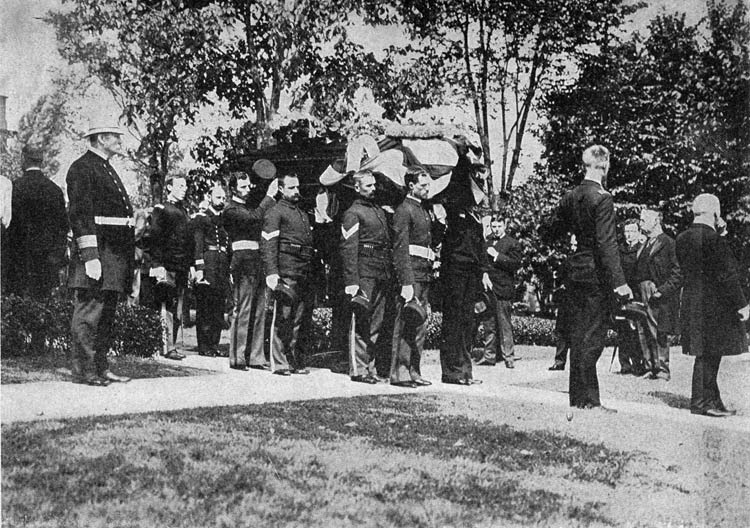
Casket being carried from the Milburn house. Image source: private collection
While the service was underway, military detachments were assembling along Delaware in front of the house. These would escort the hearse and officials to the city hall on Franklin Street where the casket would lie in state: the band of the 65th National Guard Regiment; Companies I and L of the 14th U.S. Infantry at Fort Porter; marines; artillery; the 74th National Guard Regiment; sailors and marines from the U.S.S. Michigan. The array of troops extended along Delaware from West Ferry almost to Cleveland Avenue.
Attendees and foreign commissioners from the Pan-American lined the walkway from the porch to the street as eight Army and Navy men carried the casket half-covered with the American flag to the hearse waiting at the curb. The band played "Nearer My God to Thee." And then all was silent on the street. "So profound was this silence that the tiny ticking of the telegraph instruments in the tents could be heard plainly."

Escorted procession leaving the Milburn house for Buffalo City Hall. Image source: The True Story of the Assassination...
The procession proceeded slowly along Delaware Avenue. "It was 11:45 when the hearse crossed West Ferry Street. Far up ahead the band was playing the dead march...Along each side of the street stood unbroken rows of men, women and children, three, four and five deep...Crepe was on all the houses along the route of the procession. The American flags, which had been displayed so gladly when the late President came to the city, were draped with crepe...the streets through which the President's body will be taken today...will show lines of houses with unbroken decoration of black and white."
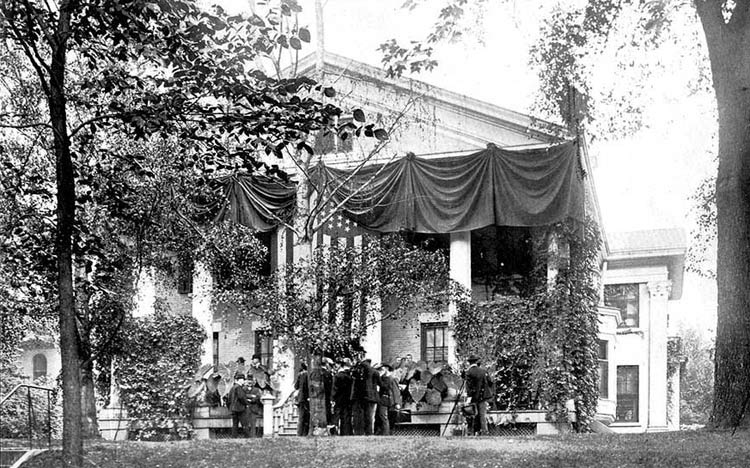
Wilcox home 646 Delaware, draped in mourning. Image source: The True Story of the Assassination...
"As the sad music of the dead march sounded ahead of the procession, many of the waiting men and women along the line began to weep. It was an unparalled scene of grief...The church bells began to toll dolefully, mournfully, their cadence in time with the slow tread of the troops...The procession passed the Wilcox home, where the new President is living, at 12:20 o'clock. Across the entire front of the home was a broad band of black...The best view of the procession was to be had by standing in the middle of Delaware Avenue in the vicinity of Edward Street and noting it as it came over the crest of the hill and slowly moved down the slope. First, was the thin red line of blue and yellow policemen on prancing horses. Then came the soldiery, a broad rectangle of gleaming steel that showed like a shining white expanse filling the avenue from curb to curb and stretching for a distance of almost two blocks. Back of them came the carriages, a long black line that seemed to undulate and sway from side to side. The hearse was easily distinguishable not only by the fact that two men rode upon its box, but also because round about it there was a cleared space as if it were something apart, in itself, from all the rest of the procession."

Carrying McKinley's casket into Buffalo City Hall. Image source: NYPL.
See a current view of this entrance here.
People knew that the procession would end at the Franklin Street entrance to City Hall (called Old County Hall in 2015). Crowds began to surge forward as the procession neared and police with reinforcements had to clear the way through Niagara Square. Rain began to fall around 1 p.m. as the procession turned onto Eagle and then Franklin.
To view the Edison film of the funeral procession and the body being carried into City Hall, look here. (A 7-minute MP4 file.)
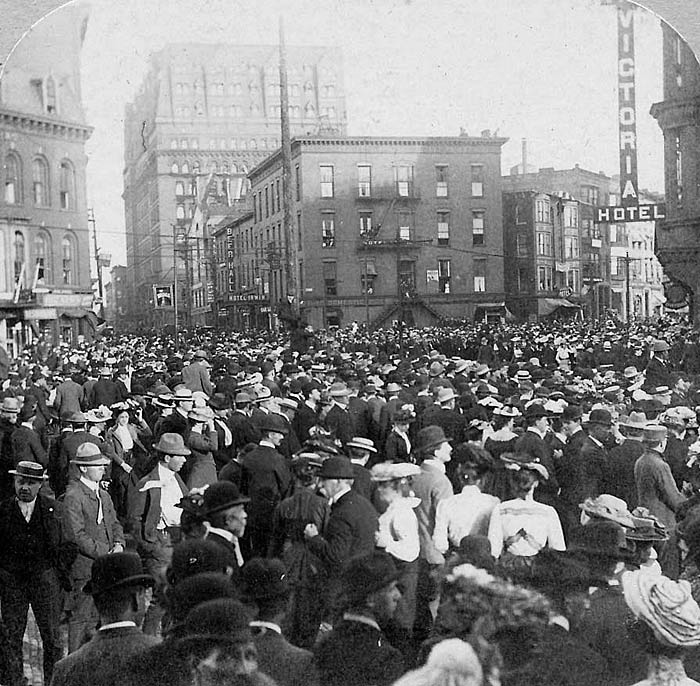
Crowds in front of City Hall. Image source: private collection
"Ropes had been stretched to hold back the crowd at the corner of Church Street and Delaware Avenue, and at all other corners in the vicinity of the hall. Back of these ropes as far as one could see were people. To count or estimate them was impossible. There simply were people as far as one could see and the farther one went to see the more people appeared. The rain made no difference to them. Those who had umbrellas hoisted them and those who had not crowded in closer...Rain was pouring in torrents as the police rode past the Franklin Street front of the City Hall."
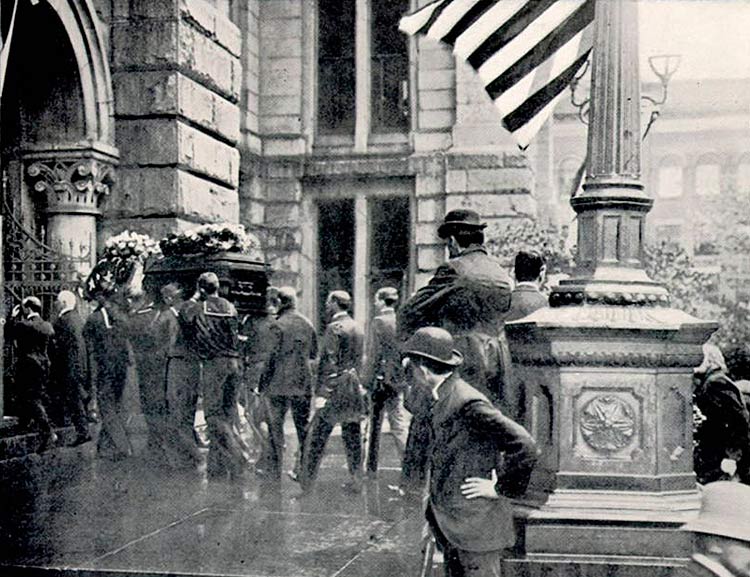
Carrying the Casket into Buffalo City Hall. Image source: UB/Buffalo Courier
The troops in their columns halted in front of City Hall, facing it as they had the Milburn house. The band again played "Nearer My God to Thee" as the hearse was opened and the casket carried into City Hall. It was placed on a catafalque and the half-cover removed from the casket. A glass cover revealed the President's upper body and face. (This would be the third President to lie in state in Buffalo. The first was Abraham Lincoln, who was on view in the old St. James Hall; the second was former President Fillmore, in St. Paul's Cathedral.)
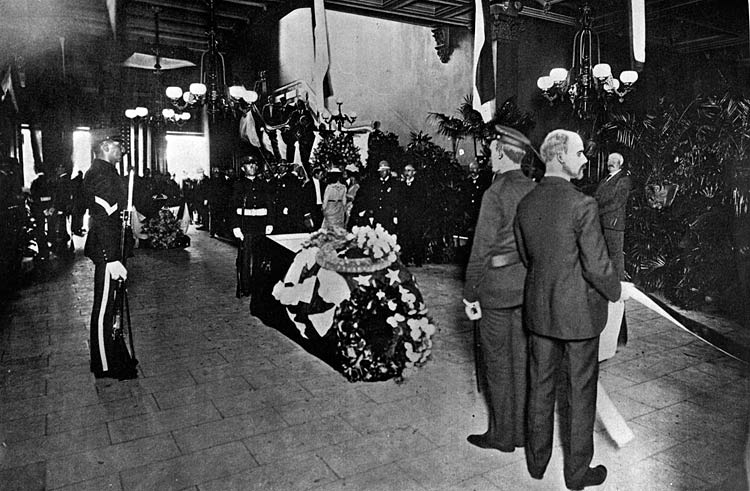
McKinley casket in state in City Hall lobby. Image source: Leslie's Weekly
The first to view the President lying in state in the City Hall lobby were President Roosevelt, Governor Odell, and Senator Fairbanks of Ohio. They left by the Delaware Avenue exit and the G.A.R. veterans, fellow Civil War veterans of William McKinley, passed by next. In the photo above is a man holding long ribbons. These were used for form two lines, one on either side of the casket. The public would finally have its turn to pay respects to the dead President. They were admitted at the Frankln Street doors in two lines, each line consisting of two columns. They passed by the casket without stopping and exited through the Delaware Avenue doors at the other side.
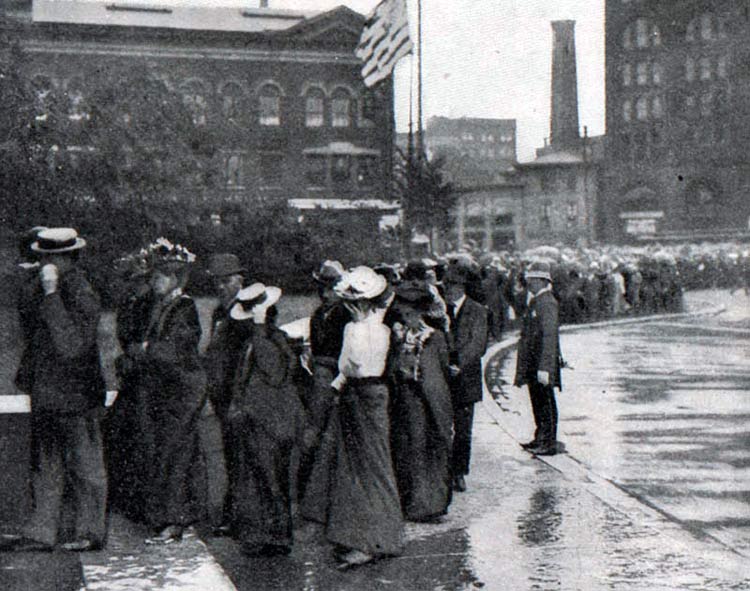
Buffalo citizens entering City Hall to pay their respects. Image source: UB/Harper's Weekly
"The people started forward with a rush, but were promptly checked by the police and thereafter, during all hours of the afternoon and evening, there was no confusion or turmoil among those in the lines of twos...Through the driving rain the thousands began to stream in and stream out of the City Hall. They were drenched to the skin, their clothes were sopping wet, streams of water trickled from them as they passed through the rotunda causing little pools to form which were swept up from time to time, and when the floor became slippery sawdust was sprinkled over the marble tiling and when the sawdust became sopping it was removed and more dry dust substituted for it."
Mrs. McKinley had requested that her husband's body be returned to the Milburn house so she could have one last night with him, but by sunset the crowd was still great. She agreed to allow the body to remain in City Hall overnight. Officials told the people waiting in what was now a windy night that they would all have the chance to pay their respects. The last mourners passed through at 10:40 p.m. Conservative estimates placed the number who viewed McKinley's casket in City Hall at 75,000.
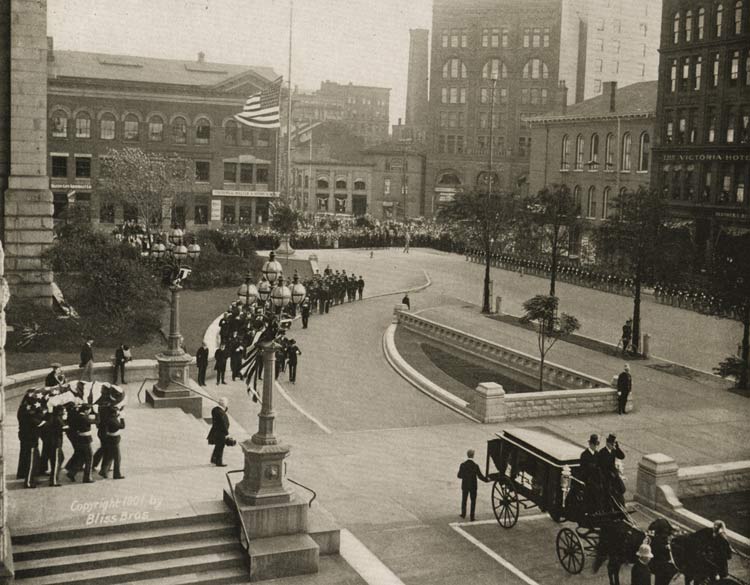
Carrying the casket out of City Hall for the train station. Image source: private collection
The next morning, September 16, was the scheduled departure of President McKinley, President Roosevelt, the cabinet, all McKinley relatives from Buffalo. Another procession of military escorts would lead the way to the Exchange Street train station via Church, Main, Exchange. Despite the 8 a.m. start time, the streets were again crowded.

Military units leading the way to the train station. Image source: private collection
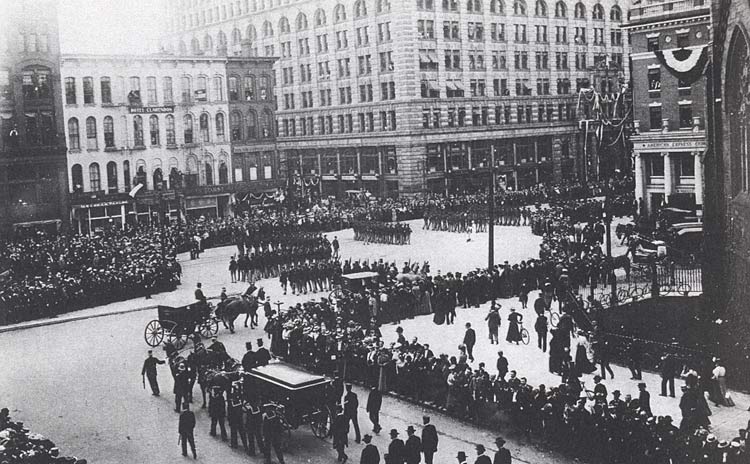
Procession turning onto Main Street from Church Street, Ellicott Square building in center. Image source: TBHM
"All along the line the streets were crowded with dense masses of people from curbs to buildings. The crowd completely filled the open space at the intersection of Niagara, Main and Church streets, except for the narrow passageway left for the escort...All the windows in Main Street buildings were filled. All along the line women had their handkerchiefs to their eyes and men pulled their hats down low over their foreheads...There was absolute silence, except for the strains of music from the band and the occasional smothered sob of someone in the crowd of grieving spectators."
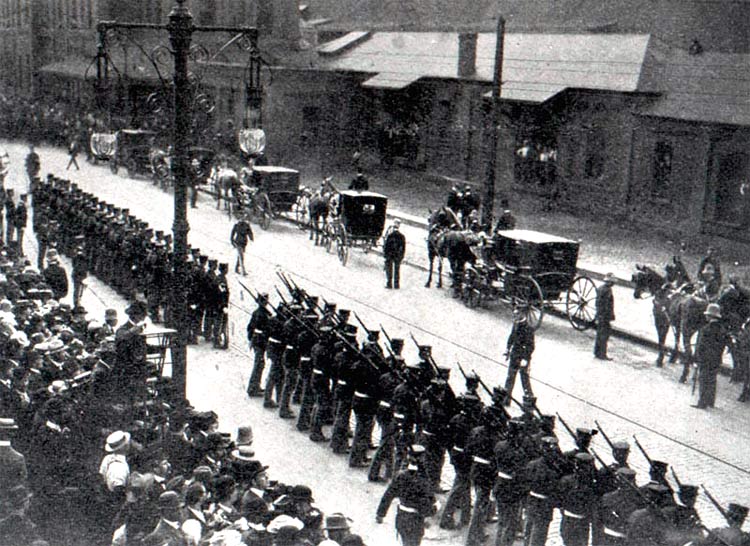
Troops in formation at the NY Central station, Exchange St. Image source: UB/Harper's Weekly
The New York Central train station had been cleared of all people. The tracks were cleared by a train that left 15 minutes ahead of the funeral train. By the time the procession reached the baggage entrance of the station, Mrs. McKinley and her relatives had already boarded. The Pennsylvania Railroad train was made up of seven Pullman cars: the Raleigh and Belgrade (press); the Waldorf (dining); the Naples (senators); Hungary (President Roosevelt and cabinet); Olympia (Mrs. McKinley); and observation car Pacific, where the casket was placed on a raised platform so that it could be seen as it passed populated areas.
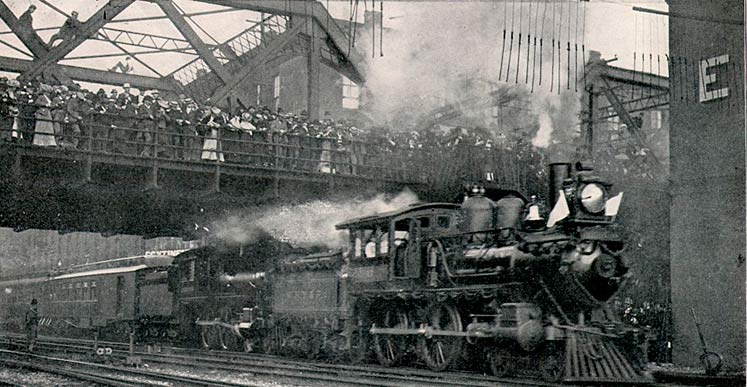
Train leaving Buffalo on the way to Washington. Image source: UB
The train was powered by two locomotives: #408 and #37. It left Buffalo at 8:34, and would stop at Olean, Emporium Junction, Renovo, Williamsport, Sunbury, Harrisburg, York, and Baltimore before reaching Washington where a state funeral would be held. The journey would not end until Mrs. McKinley had her husband's body back in Canton, Ohio, where he was buried. The Exposition closed again for the day of his burial, September 19.

The lobby of Old County Hall in 2015, velvet ropes identifying the location of McKinley's casket as he lay in state.

Detail of the above photo.
Quotations in this pictorial were taken from the Buffalo Courier's account of the days after President McKinley's death. The articles may be accessed in the digitized Pan-American scrapbooks maintained by the Buffalo & Erie County Library. Thank you, librarians.